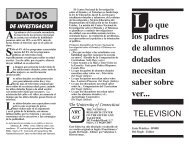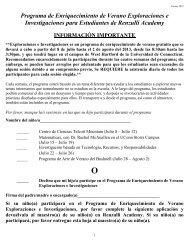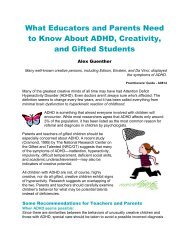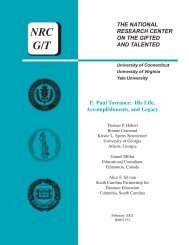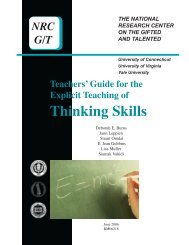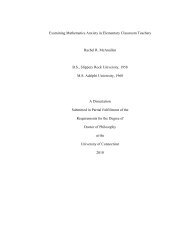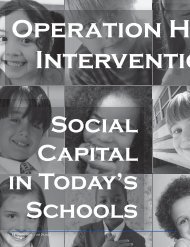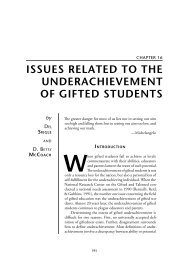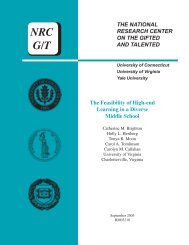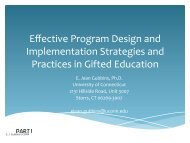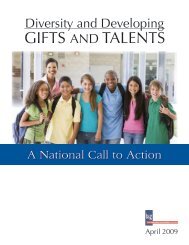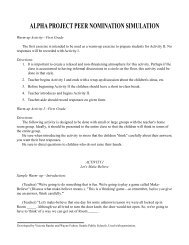Giftedness and High School Dropouts - Neag Center for Gifted ...
Giftedness and High School Dropouts - Neag Center for Gifted ...
Giftedness and High School Dropouts - Neag Center for Gifted ...
You also want an ePaper? Increase the reach of your titles
YUMPU automatically turns print PDFs into web optimized ePapers that Google loves.
17<br />
A causal-comparative design was used in this study because the NELS:88 data are<br />
collected from self-administered surveys. A causal-comparative design allows <strong>for</strong> the<br />
investigation of possible cause-<strong>and</strong>-effect relationships in a situation where experimental<br />
manipulation is impossible (Borg & Gall, 1989; Kerlinger, 1973).<br />
Samples<br />
The sample in this study is composed of the students who were eighth graders in<br />
1988 <strong>and</strong> participated in the base year through the third follow-up survey of NELS:88.<br />
The sample in Study 1 consists of dropout students who were not in an academic program<br />
leading to a high school diploma, had not received a GED by the spring 1992, <strong>and</strong> had<br />
completed the Second Follow-up Dropout Questionnaire. In this study, to apply a more<br />
flexible definition of gifted, gifted students were defined as those who participated in<br />
their school district's gifted program or who had been enrolled in three or more classes in<br />
advanced, enriched, or accelerated English, social studies, science, or math (variable<br />
codes, BYS66A, B, C, BYS68A). Among 1,285 students who completed the Second<br />
Follow-up Dropout Questionnaire, 334 were identified as gifted.<br />
The sample in Study 2 consists of gifted students who were eighth graders in 1988<br />
<strong>and</strong> participated in all four rounds of the survey. It should be noted that gifted students<br />
who dropped out of school in Study 1 <strong>and</strong> Study 2 are not exactly the same group,<br />
because some of the students who dropped out of school in Study 1 might have returned<br />
to school be<strong>for</strong>e the third follow-up, classifying them as non-dropouts in Study 2. Also,<br />
gifted students who dropped out of school in Study 1 did not participate in the third<br />
follow-up survey, thus decreasing the number of students in the third follow-up (see<br />
Figure 2). Among 12,625 students who participated in the four rounds of the survey, a<br />
total of 3,520 gifted students were identified as a sample using the same definition of<br />
gifted as in Study 1. In Study 2, dropout students were defined as students who were not<br />
graduates or GED/certificate holders (f3diplom=6) in 1994. The dropout <strong>and</strong> gifted<br />
status of the sample is described in Table 2. Of the students identified as gifted <strong>for</strong> this<br />
study, 95% (3,343) received their high school diploma, while 5% (177) were considered<br />
dropouts. Approximately 5% of students identified as non-gifted dropped out of school<br />
as well.<br />
Weights <strong>and</strong> St<strong>and</strong>ard Error of the Study<br />
The variables used in Study 1 <strong>and</strong> Study 2 were all included in the NELS:88 third<br />
follow-up, public use data files. The operational definitions <strong>and</strong> NELS:88 coding<br />
schemes (in parentheses) <strong>for</strong> each variable are described in the Appendix A.



